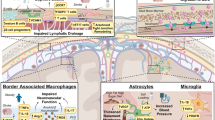Abstract
The patients suffering from acute cerebral infarction in the presence of diabetes mellitus (DMCI) often have poor clinical outcomes when compared with those in the absence of diabetes mellitus (non-DMCI), but the corresponding differences in pathology still remain elusive. Here, we investigated the proliferation of microglia in DMCI and non-DMCI. Patients who came to autopsy involved four DMCI cases and four non-DMCI cases. The peri-infarct region and the equivalent non-lesional region in the contralateral hemisphere were removed and analyzed. The hematoxylin–eosin staining and immunohistochemistry staining with anti-ferritin were used for evaluating the microglial activation. We found a more evident microglial proliferation in the peri-infarct region (P < 0.01) and in the non-lesional hemisphere (P < 0.05) in DMCI than in non-DMCI patients. In addition, neuronophagia was observed in peri-infarct region of DMCI. Future studies are warranted to further clarify the influence of microglial activation in DMCI.

Similar content being viewed by others
References
Fuller JH, Shipley MJ, Rose G et al (1983) Mortality from coronary heart disease and stroke in relation to degree of glycaemia: the Whitehall study. Br Med J 287:867–870
Lukovits TG, Mazzone T, Gorelick PB (1999) Diabetes mellitus and cerebrovascular disease. Neuroepidemiology 18:1–14
Kissela B, Air E (2006) Diabetes: impact on stroke risk and poststroke recovery. Semin Neurol 26:100–107
Olsson T, Viitanen M, Asplund K et al (1990) Prognosis after stroke in diabetic patients. A controlled prospective study. Diabetologia 33:244–249
Megherbi SE, Milan C, Minier D et al (2003) European BIOMED Study of Stroke Care Group: association between diabetes and stroke subtype on survival and functional outcome 3 months after stroke. Data from the European BIOMED Stroke Project. Stroke 34:688–694
Weimar C, Mieck T, Buchthal J et al (2005) German Stroke Study Collaboration. Neurologic worsening during the acute phase of ischemic stroke. Arch Neurol 62:393–397
Zangerle A, Kiechl S, Spiegel M et al (2007) Recanalization after thrombolysis in stroke patients: predictors and prognostic implications. Neurology 68:39–44
Mankovsky BN, Patrick JT, Metzger BE et al (1996) The size of subcorticol ischaemic infarction in patients with and without diabetes mellitus. Clin Neurol Neurosurg 98:137–141
Fisher CM (1991) Lacunar infarcts. A review. Cerebrovasc Dis 1:311–320
Megherbi S-A, Milan C, Minier D et al (2003) Association between diabetes and stroke subtype on survival and functional outcome 3 months after stroke. Data from the European BIOMED Stroke Project. Stroke 344:688–694
Zheng Z, Yenari MA (2004) Post-ischemic inflammation: molecular mechanisms and therapeutic implications. Neurol Res 26:884–892
Wang Q, Tang XN, Yenari MA (2007) The inflammatory response in stroke. J Neuroimmunol 184:53–68
Dirnagl U, Iadecola C, Moskowitz MA (1999) Pathobiology of ischaemic stroke: an integrated view. Trends Neurosci 22:391–397
Lai AY, Todd KG (2006) Microglia in cerebral ischemia: molecular actions and interactions. Can J Physiol Pharmacol 84:49–59
Lalancette-Hébert M, Gowing G, Simard A et al (2007) Selective ablation of proliferating microglial cells exacerbates ischemic injury in the brain. J Neurosci 27:2596–2605
Lambertsen KL, Clausen BH, Babcock AA et al (2009) Microglia protect neurons against ischemia by synthesis of tumor necrosis factor. J Neurosci 29:1319–1330
Schroeter M, Jander S, Witte OW et al (1994) Local immune responses in the rat cerebral cortex after middle cerebral artery occlusion. J Neuroimmunol 55:195–203
Wood PL (1995) Microglia as a unique cellular target in the treatment of stroke: potential neurotoxic mediators produced by activated microglia. Neurol Res 17:242–248
Ekdahl CT, Kokaia Z, Lindvall O (2009) Brain inflammation and adult neurogenesis: the dual role of microglia. Neuroscience 158:1021–1029
Kaneko Y, Kitamoto T, Tateishi J et al (1989) Ferritin immunohistochemistry as a marker for microglia. Acta Neuropathol 79:129–136
Kim SU, de Vellis J (2005) Microglia in health and disease. J Neurosci Res 81:302–313
Krady JK, Basu A, Allen CM et al (2005) Minocycline reduces proinflammatory cytokine expression, microglial activation, and caspase-3 activation in a rodent model of diabetic retinopathy. Diabetes 54:1559–1565
Yrjanheikki J, Tikka T, Keinanen R et al (1999) A tetracycline derivative, minocycline, reduces inflammation and protects against focal cerebral ischemia with a wide therapeutic window. Proc Natl Acad Sci USA 96:13496–13500
Zhang N, Komine-Kobayashi M, Tanaka R et al (2005) Edaravone reduces early accumulation of oxidative products and sequential inflammatory responses after transient focal ischemia in mice brain. Stroke 36:2220–2225
Chuaqui R, Tapia J (1993) Histologic assessment of the age of recent brain infarcts in man. J Neuropathol Exp Neurol 52:481–489
Mena H, Cadavid D, Rushing EJ (2004) Human cerebral infarct: a proposed histopathologic classification based on 137 cases. Acta Neuropathol 108:524–530
Wong KT, Munisamy B, Ong KC et al (2008) The distribution of inflammation and virus in human enterovirus 71 encephalomyelitis suggests possible viral spread by neural pathways. J Neuropathol Exp Neurol 67:162–169
Stolzing A, Grune T (2004) Neuronal apoptotic bodies: phagocytosis and degradation by primary microglial cells. FASEB J 18:743–745
Takahashi K, Rochford CD, Neumann H (2005) Clearance of apoptotic neurons without inflammation by microglial triggering receptor expressed on myeloid cells-2. J Exp Med 201:647–657
Witting A, Muller P, Herrmann A et al (2000) Phagocytic clearance of apoptotic neurons by microglia/brain macrophages in vitro: involvement of lectin-, integrin-, and phosphatidylserine-mediated recognition. J Neurochem 75:1060–1070
Author information
Authors and Affiliations
Corresponding author
Rights and permissions
About this article
Cite this article
Li, G., Xu, X., Wang, D. et al. Microglial activation during acute cerebral infarction in the presence of diabetes mellitus. Neurol Sci 32, 1075–1079 (2011). https://doi.org/10.1007/s10072-011-0632-2
Received:
Accepted:
Published:
Issue Date:
DOI: https://doi.org/10.1007/s10072-011-0632-2




